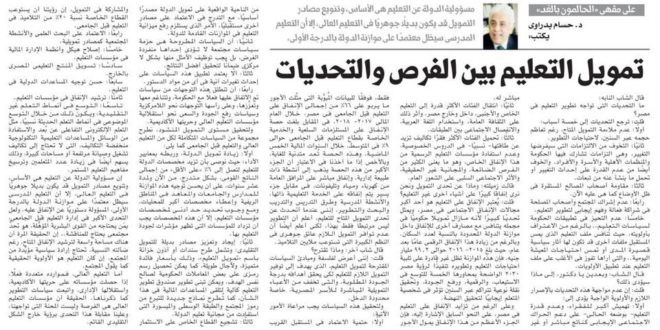The young man said:
What are the challenges facing the development of education in Egypt?
I said: The challenges are due to five reasons:
First: the inadequacy of the available funding, despite its increasing size over the years, to the needs of development.
Second: Fear of the obligations that change will impose, which are obligations in which the government, civil organizations, the family and individuals participate, and also fear of not being able to bring about change or bear the consequences arising from it.
Third: The resistance of the owners of stable interests in light of the situation as it is now.
Fourth: Not involving the community and stakeholders in an effective partnership and a positive understanding of education development.
Fifth: Impartiality in the government’s implementation of education policies…despite acknowledging its priority, as the education file that affects the future competes with other files that may have short-term political effects or affect daily living needs..which I see mostly winning over the education file when implementing priorities. .
The young man said: And then, Doctor, what will that lead to?
I said: Failure to confront these challenges with the necessary determination and due priority leads to:
First: the greater marginalization of the poor, and the inability of education – in its current state – to support positive social mobility as a direct or indirect outcome of it.
Second: The transfer of the most capable groups to private and foreign education, inside and outside Egypt, and its impact on general culture, the use of the Arabic language, and the social separation between classes.
Third: The cost of private lessons for the poorest groups is relatively higher than their capacity, and that official educational institutions do not benefit from this private spending, which means a lot of missed opportunities, unrealistic freebies, and a negative social impact on public sentiment.
His colleague said: What about the funding challenge when we see huge spending on things other than education?
I said: Expenditure on education is one of the largest areas of social spending in Egypt, and it represents a great challenge because it is still government funding in its entirety that competes with other banks for spending within the state’s limited budget in relation to the population. Despite the increase in this digital spending year after year, reaching 2015-2016 about 99.2 billion pounds, this budget remains unable to meet the needs of education and develop it in implementation of Egypt’s vision 2030, which is clear with its five axes of expansion in absorption, digitalization, raising quality, and achieving a qualitative leap. It accumulates over the years and affects the learner’s personality positively to achieve renaissance.
Despite the increase in spending on education in Egypt, as previously mentioned, the bulk of this spending finances wages only. According to the classified data, wages represented more than 66% of total spending on pre-university education in Egypt, during the fiscal year 2017-2018, in contrast, the share of spending on commodity and service requirements for the pre-university education sector was about 9% on average, during the past five fiscal years, and this share is considered very low, especially if we take into account that the bulk of this share goes to Activities of an administrative nature, and direct spending on public utilities such as electricity, water and telephones, in return for a small portion spent on the educational service itself, school activities, teaching methods, training, research and development. When I talk about the funding challenge for education, I know that development is not only related to this, but I also know that lack of funding is a fundamental constraint in large systems that accommodate millions of students.
Another young man said: What do you suggest?
I said: I am presenting the philosophy and principles of the proposed policies for financing education, which aims to provide the necessary financing for education to achieve its objectives with the required degree of quality, and which alleviates the direct financial burdens of Egyptian families, especially those with limited income.
In order to achieve these policies, the following matters must be taken into account:
First: The inevitability of relying in the near future on realistic state funding as a primary source, with gradual dependence on other sources in the future, which necessitates raising the education budget in the state’s upcoming budgets.
Second: The proposed policies are a set of combined policies, one of which does not serve a singular purpose, but rather the optimal of them must be employed in a decentralized manner to ensure the best results.
Third: The implementation of these policies should not depend on making immediate changes in any of the articles of the constitution.
Fourth: That these trends start from policies that have already been agreed upon with the government, are in harmony with and reinforce them, especially the trends towards decentralization, policies to raise quality, and the pursuit of the independence and academic freedom of higher education institutions.
To achieve the desired level of funding, we propose a set of integrated policies for both higher education and pre-university education, as follows:
First: Increasing state funding, and linking it to performance standards: We recommend that the state’s allocations for education be increased to “at least” 6% of the gross national product, gradually, from now and for a period of ten years, provided that this budget is better directed to schools, universities and institutes in the regions. In rural areas and giving larger allocations to localities, and with the need to specify a minimum allocation for educational institutions, these allocations must be increased for institutions that show indicators of the quality of education in them.
Second: Finding and promoting alternative sources of traditional financing: It includes offering bonds or treasury bills in the name of “education finance”, at distinct interest rates and for long terms, and a nominal fee can be charged on some government transactions for the same goal. The development of the Education Development Fund can be adopted as a mechanism for receiving financial assistance in this regard, and new models for donation from the symbols of society and the middle and affluent classes who have benefited from free state education can be proposed.
Third: Encouraging the private sector to invest and participate in financing. Our vision is for the private sector to absorb 20% of the total
A teacher in pre-university education.
Fourth: Relying on scientific research and community activities as funding sources.
Fifth: Reforming the structure and systems of financial management in educational institutions.
Sixth: Marketing the Egyptian educational product abroad.
Seventh: Good directing international aid in education.
Eighth: Rationalizing expenditures in educational institutions.
Ninth: Expansion of non-traditional learning patterns: This is through the objective expansion of relatively modern learning patterns, such as remote interactive e-learning and benefiting from low-cost technological educational aids and aids, which do not require high operating and maintenance costs or large spaces, and this contributes to Also in increasing the number of learners and consolidating the concepts of continuing education.
The state’s responsibility for education is the basis, and diversification of funding sources may be a fundamental alternative in higher education, but school education will remain dependent on the state budget in the first place, which is constitutionally responsible for spending on it. Perhaps the biggest challenge in managing pre-university education, with its qualified human forces, is a societal challenge that needs to be discussed.. The bitter truth is that there is a wide space to rationalize the available spending, despite its relative meagerness, that needs a supportive political will from the community, if education is the priority. The truth is what society says.
As for higher education, its resources are indeed numerous, if its institutions obtain their academic freedom and administrative independence, and follow the development policies as we mentioned. The truth is that higher education institutions are the opportunity and not the ordeal facing us, and we must meet this challenge with a vision outside the existing traditional form.
 Dr. Hossam Badrawi Official Website
Dr. Hossam Badrawi Official Website


